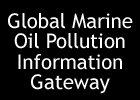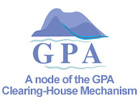|
|
|

Discharges
of oil from shipping, offshore extraction of oil, and transport
of oil in pipelines is the result of either accidents or "normal",
deliberate operational discharges. Accidental
discharges (oil spills) occur when vessels collide
or come in distress at sea (engine breakdown, fire, explosion)
and break open, or run aground close to the shore, or when
there is a blowout of an offshore oil well, or when a pipeline
breaks. Much can be done to avoid accidents, but there will
always be unfortunate circumstances and situations that cause
accidents to happen. Operational
discharges, on the other hand, are mostly deliberate
and "routine", and can to a very large extent be
effectively controlled and avoided. It is much a question
combining available technical solutions with information,
education and a change of attitude among ship-owners, mariners,
offshore platform and pipeline operators.
 Volatile organic compounds (VOCs) are a mixture of
propane, butane and several other gases given off through
the vaporisation of crude oil and refined products, such
as petrol. VOCs are usually divided into non-methane (nmVOCs)
and methane. As soon as petroleum is handled in the open
air, vapours escape unless something is done to contain
them. These hydrocarbons in gaseous form can be emitted
into the atmosphere from platforms (extraction of oil),
tankers (transportation of oil), terminals (loading and
unloading of oil), filling stations (petrol tanking) refineries
(processing of oil), pipelines (leakages of oils and gas),
and aircraft (refueling and fuel dumping). Hydrocarbon vapours
can be recovered and "recycled" as liquid fuel.
They are collected and condensed when petroleum products
are being loaded and unloaded at terminals, refineries and
petrol stations.
Volatile organic compounds (VOCs) are a mixture of
propane, butane and several other gases given off through
the vaporisation of crude oil and refined products, such
as petrol. VOCs are usually divided into non-methane (nmVOCs)
and methane. As soon as petroleum is handled in the open
air, vapours escape unless something is done to contain
them. These hydrocarbons in gaseous form can be emitted
into the atmosphere from platforms (extraction of oil),
tankers (transportation of oil), terminals (loading and
unloading of oil), filling stations (petrol tanking) refineries
(processing of oil), pipelines (leakages of oils and gas),
and aircraft (refueling and fuel dumping). Hydrocarbon vapours
can be recovered and "recycled" as liquid fuel.
They are collected and condensed when petroleum products
are being loaded and unloaded at terminals, refineries and
petrol stations.
 Polycyclic aromatic hydrocarbons (PAHs) include around
a hundred of the petroleum hydrocarbons and are natural
constituents of oil. When fossil fuels are burnt, especially
on a small scale when combustion is often incomplete, PAH
compounds form and escape to the atmosphere or to water.
PAHs occur both in gaseous form and bound to particles (soot).
Large amounts of PAHs are emitted from recreational vessels
due to inadequate fuel combustion in two-stroke (outboard)
engines.
Polycyclic aromatic hydrocarbons (PAHs) include around
a hundred of the petroleum hydrocarbons and are natural
constituents of oil. When fossil fuels are burnt, especially
on a small scale when combustion is often incomplete, PAH
compounds form and escape to the atmosphere or to water.
PAHs occur both in gaseous form and bound to particles (soot).
Large amounts of PAHs are emitted from recreational vessels
due to inadequate fuel combustion in two-stroke (outboard)
engines.
FROM SHIPS AND BOATS
 Tankers: When crude oil is unloaded from a tanker,
the cargo tanks will contain a mixture of gases, including
VOCs. When the tank is filled again with crude oil, the
gases are vented to the open air. However, with new technology
the VOCs can be condensed and recovered and used as tanker
fuel (instead of the much "dirtier" bunker fuel).
In other words, when an oil tanker is making a delivery,
vapours that escape will be captured and go back into the
tanker. On board a tanker, emissions of VOCs can be controlled
by allowing a slight overpressure in the tanks.
Tankers: When crude oil is unloaded from a tanker,
the cargo tanks will contain a mixture of gases, including
VOCs. When the tank is filled again with crude oil, the
gases are vented to the open air. However, with new technology
the VOCs can be condensed and recovered and used as tanker
fuel (instead of the much "dirtier" bunker fuel).
In other words, when an oil tanker is making a delivery,
vapours that escape will be captured and go back into the
tanker. On board a tanker, emissions of VOCs can be controlled
by allowing a slight overpressure in the tanks.
 Pleasure craft: Two-stroke petrol outboard engines
are popular and common in pleasure craft (recreational vessels,
leisure craft). It is a compact, simple engine which requires
little maintenance. In relation to its weight, the two-stroke
outboard engine generates much power. It is reliable in
operation and comparatively cheap. From an environmental
point of view, however, these engines are bad news. They
are extremely fuel-consuming due to low thermal efficiency
and cause high emissions of uncombusted hydrocarbons (PAHs)
and carbon monoxide. The PAHs virtually "disappear"
into the water stirred up by the propeller and get dissolved
in the water, i.e., transformed from air pollutants to water
pollutants. Considerable damage is caused by these hydrocarbon
compounds to water-living organisms (to which they are toxic),
especially in shallow coastal areas which serve as marine
"nurseries".
Pleasure craft: Two-stroke petrol outboard engines
are popular and common in pleasure craft (recreational vessels,
leisure craft). It is a compact, simple engine which requires
little maintenance. In relation to its weight, the two-stroke
outboard engine generates much power. It is reliable in
operation and comparatively cheap. From an environmental
point of view, however, these engines are bad news. They
are extremely fuel-consuming due to low thermal efficiency
and cause high emissions of uncombusted hydrocarbons (PAHs)
and carbon monoxide. The PAHs virtually "disappear"
into the water stirred up by the propeller and get dissolved
in the water, i.e., transformed from air pollutants to water
pollutants. Considerable damage is caused by these hydrocarbon
compounds to water-living organisms (to which they are toxic),
especially in shallow coastal areas which serve as marine
"nurseries".
FROM
OFFSHORE DRILLING
 Activities that cause air pollution (VOCs, methane, carbon
dioxide, and nitrogen oxides) from offshore installations
include gas venting on shuttle tanks when oil is loaded
onto these tanks for transport, as well as gas flaring,
gas turbine exhausts, diesel or fuel exhausts, well testing
and diffuse emissions from the platform and drilling place.
About two-thirds of the air pollutants are VOCs and they
mainly derive from the offshore storing and loading of crude
oil. About 70 per cent of the VOCs can be recovered (see
above).
Activities that cause air pollution (VOCs, methane, carbon
dioxide, and nitrogen oxides) from offshore installations
include gas venting on shuttle tanks when oil is loaded
onto these tanks for transport, as well as gas flaring,
gas turbine exhausts, diesel or fuel exhausts, well testing
and diffuse emissions from the platform and drilling place.
About two-thirds of the air pollutants are VOCs and they
mainly derive from the offshore storing and loading of crude
oil. About 70 per cent of the VOCs can be recovered (see
above).
FROM
TERMINALS AND REFINERIES
 Crude oil is transported to an oil terminal — a land-based
facility which receives and stores crude oil and other products
from offshore oil production — by ship or pipeline.
In port, at the terminal, it is technically possible to
recover hydrocarbon vapours.
Crude oil is transported to an oil terminal — a land-based
facility which receives and stores crude oil and other products
from offshore oil production — by ship or pipeline.
In port, at the terminal, it is technically possible to
recover hydrocarbon vapours.
FROM
AIRCRAFT
 Human activities causing atmospheric deposition of hydrocarbons
on the sea include military and commercial jets that occasionally
jettison excess fuel over the ocean.
Human activities causing atmospheric deposition of hydrocarbons
on the sea include military and commercial jets that occasionally
jettison excess fuel over the ocean.
|
- MARPOL
73/78 Convention: Prevention
of air pollution.
- Statoil:
Health,
safety and the environment (go first to "Environment"
- then to "Clean air")
- Convention
on Long-range Transboundary Air Pollution: VOC
Protocol. Protocol concerning the Control of Emissions
of Volatile Organic Compounds or their Transboundary Fluxes.
 UNEP and OGP:
Environmental management in oil and gas exploration and
production. Report by UNEP Industry and Environment
(IE) and Oil Industry International Exploration and Production
Forum (now International Association of Oil & Gas Producers,
OGP). See also OGP list
of publications.
UNEP and OGP:
Environmental management in oil and gas exploration and
production. Report by UNEP Industry and Environment
(IE) and Oil Industry International Exploration and Production
Forum (now International Association of Oil & Gas Producers,
OGP). See also OGP list
of publications. - OKOOA:
Britain's
offshore oil and gas. Industry issues. (Geological settings,
exploration, development, production, sustainability-safety-the
environment). United Kingdom Offshore Operators Association
(OKOOA).
- U.S.
Minerals Management Service: International
Workshop on nitrogen oxides control for offshore operations.
- U.S.
National Academy of Sciences: Oil
in the sea III: Inputs, fates and effects. Report 2002
by the National Research Council (NRC) Committee on Oil
in the Sea: Inputs, Fates, and Effects. See also U.S. National
Academies press
release about the conclusions in the NRC Report.
- GESAMP:
"Impact of oil and related chemicals and wastes on
the marine environment". GESAMP Report 50, 1993. Not
available online, but the figures referred to can also be
found in the online article "Oil
pollution of the sea".
-
UN Atlas of the Ocean: "The impact of marine pollution".
Report (1980) by Douglas J. Cuisine and John P. Grant. Table
published on the UN
Atlas of the Oceans web site.
|

|
|


